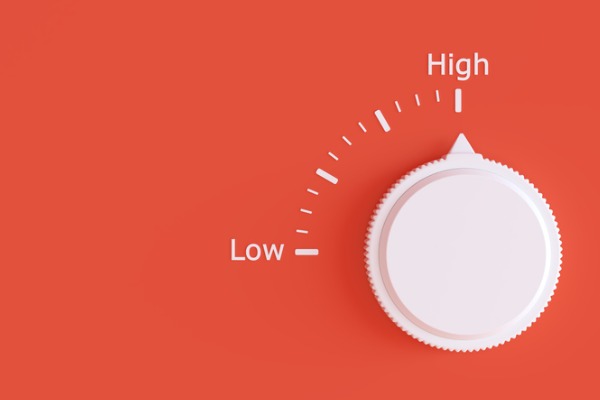When should you de-risk your portfolio?
While reducing risk in your portfolio is not a decision to take lightly, in some instances in can be a sensible thing to do, writes Faith Glasgow.
14th February 2024 10:38
by Faith Glasgow from interactive investor

Most of us are well aware that there is inherent risk involved in putting our savings into the stock market, but that uncertainty and volatility are the trade-offs we have to accept in return for superior long-term returns.
We also know that capacity to stomach risk is a very personal thing - one person’s sleepless nights scenario won’t worry someone else with a higher risk tolerance at all.
- Invest with ii: Open a Stocks & Shares ISA | ISA Investment Ideas | Transfer a Stocks & Shares ISA
However, there are certain contexts in which it makes a lot of sense to think carefully about the amount of risk your portfolio is exposed to, and potentially to take steps to reduce it. Below, we take a look at them, and highlight some considerations to bear in mind should you decide to de-risk.
1) Excessive risk
A hearty appetite for risk is one thing, but too cavalier an attitude to investing is asking for trouble. If your portfolio is heavily weighted towards individual small company stocks, or technology funds, or China – or indeed any single, potentially racy focus – the danger is that if something goes wrong for that sector or region, it will be seriously impacted.
Concentrating your cash among just a few big blue-chips could be a similarly risky approach, simply because if any single holding hits the skids it could do significant damage to your overall portfolio.
Diversification across a range of investments with different market capitalisations, regional focuses and asset classes helps to reduce overall risk, because the chances of widespread damage are lessened.
Moreover, some types of asset have so-called low correlation to each other, so when one is doing badly, the other tends to be thriving, thereby offsetting the impact to your total portfolio. Bonds and equities have historically had such a relationship.
The basic principle, therefore, is not to avoid high-risk holdings altogether, but to ensure they form a limited proportion of a well-diversified range of investments.
2) Time frame
This is an equally important consideration. The basic starting point here is that the longer you have until you’re likely to need the money, the more risk you can afford to take within a sensibly diversified portfolio. That’s because while there may be short-term pain, you have the luxury of time to wait for longer-term gains.
Thus, for example, someone setting up a self-invested personal pension (SIPP) in their 30s would be foolish to leave their money in cash or focus on bonds, because over the long term equities have historically significantly outperformed both.
The 2023 Barclays Equity Gilt study shows that over the past 50 years UK equities have produced total real returns (accounting for inflation) of 4.5%, compared with 2.4% for gilts and 0.7% for cash.
- The dangers of paying too much for your pension
- How to make the most of your pension allowances before April
Indeed, it would arguably be worthwhile having a portion of that SIPP in a more volatile but potentially more rewarding part of the market such as a smaller companies fund.
According to Trustnet, although smaller companies are hit harder in a market slump, they have tended to bounce back more energetically. Over the past 25 years, UK small-cap returns have been approximately double those of larger UK equities.
The argument for diversification still stands with a longer time frame, but at this stage you’re in a strong position to build exposure to potentially more exciting investments in your portfolio.
Conversely, if you’re saving for a specific event - say a deposit on a first home, or your child’s university fees – then it may well make sense to progressively reduce exposure to equities as the date draws nearer, eventually moving into cash or money market funds.
You really don’t want a stock market crash to knock the stuffing out of your nest egg just a year or two (or even months) before you need it.

3) Capacity to bear losses
The impact of a typical market slump on your wealth and life choices is to a large extent relative to the amount of money you had in the first place.
For a multi-millionaire it might be irritating and mean plans for an infinity pool in the holiday home have to be postponed. For a single person approaching retirement age with a few thousand quid in an ISA and a small pension, it could be life-changing - requiring them to work extra years to allow their investments time to recover, or downsize to release extra cash, or live a more frugal life in retirement.
By extension, it follows that de-risking as a means of protecting against badly timed market setbacks is more valuable for those without a lot of other means to fall back on.
Historically, de-risking has been associated particularly with retirement, because from that point people have far less capacity to supplement their situation with earned income and are partly or fully reliant on pension income. But it could equally be a consideration, as we’ve seen, for anyone heavily reliant on savings for a specifically timed event.
4) Retirement plans
In times gone by, conventional wisdom for defined contribution (DC) pension schemes was to de-risk progressively over the 15 years or so before you retired, shifting out of equities and into fixed interest investments.
The idea was that your money was both increasingly protected from the vagaries of the stock market and more or less aligned with the lifetime annuity that you were almost bound to buy with it to fund your retirement.
If you plan a “hard stop” to your working life and to buy an annuity, then it can still be a sensible idea to reduce risk.
But the backdrop has shifted significantly over the past decade or so with the pension freedom reforms of 2015. Many people at retirement age prefer to retain the flexibility of an income drawn directly from their pension pot (perhaps to supplement a phased winding down from paid employment), rather than buying an inflexible, irreversible annuity at that stage.
- Pension myths: how misconceptions could be hurting your retirement
- 9 things to learn about pensions from ii customers
The meagre annuity rates of the low-interest environment of those years has made income drawdown all the more enticing, especially as markets have basically been on an upward trajectory over that time.
As Ben Yearsley, investment consultant at Fairview Investing, observes, when you take the income drawdown route, extensive de-risking is not a great idea – particularly given that more and more people are living well into their 80s or 90s and therefore having to fund lengthy retirements.
“A lot of investors seem to think they need to de-risk when they retire,” he warns. “This isn't necessarily the case. If you retire at 60, you might have another 30 years to live, so you still need sufficient risk in your portfolio. De-risking too much runs the risk of your portfolio returns not at least keeping pace with inflation.”
De-risking deconstructed...
How should you go about it? There is no “right” way to de-risk, but Yearsley makes the point that if the portfolio is held within an individual savings account (ISA) or SIPP then at least there are no tax consequences to your decisions. “Often you find tax drives portfolio decisions, which is the wrong thing to do,” he adds.
The first exercise, once you have decided to go ahead, is to identify which are the riskier parts of your portfolio. "There are some areas that aren't at all suited to a lower-risk portfolio – frontier markets maybe, emerging market debt, micro caps,” says Yearsley. But these aren't hard and fast rules so much as a matter of personal choice: other investors might feel too vulnerable holding on to a small cap or single-sector fund.
“Of course, if the portfolio includes very high-risk areas, then it’s a much cleaner approach simply to take them out, but with less clear-cut areas of the market that’s not always an easy decision,” he adds.
A further question, when you’ve reduced or sold out of the higher-risk holdings, is what to do with the cash you’ve realised.
Says Yearsley: “If possible I would initially look to reallocate to existing funds before adding new ones in. What you don't want is a lot of small holdings, so keep that in mind - maybe 4-5% should be a minimum size for any portfolio fund or trust holding.”
In a sensibly constructed portfolio you might not need to add any new holdings – it could just be a case of reallocation to adjust the asset weights.
Overall, the need to reduce risk at a particular time is very much a reflection of your own circumstances. If the money in question is all you have and you need it now, or if it’s heavily tied up in emerging market funds and AIM stocks, then you should probably seriously consider de-risking your holdings.
These articles are provided for information purposes only. Occasionally, an opinion about whether to buy or sell a specific investment may be provided by third parties. The content is not intended to be a personal recommendation to buy or sell any financial instrument or product, or to adopt any investment strategy as it is not provided based on an assessment of your investing knowledge and experience, your financial situation or your investment objectives. The value of your investments, and the income derived from them, may go down as well as up. You may not get back all the money that you invest. The investments referred to in this article may not be suitable for all investors, and if in doubt, an investor should seek advice from a qualified investment adviser.
Full performance can be found on the company or index summary page on the interactive investor website. Simply click on the company's or index name highlighted in the article.
Please remember, investment value can go up or down and you could get back less than you invest. If you’re in any doubt about the suitability of a stocks & shares ISA, you should seek independent financial advice. The tax treatment of this product depends on your individual circumstances and may change in future. If you are uncertain about the tax treatment of the product you should contact HMRC or seek independent tax advice.
Important information – SIPPs are aimed at people happy to make their own investment decisions. Investment value can go up or down and you could get back less than you invest. You can normally only access the money from age 55 (57 from 2028). We recommend seeking advice from a suitably qualified financial adviser before making any decisions. Pension and tax rules depend on your circumstances and may change in future.